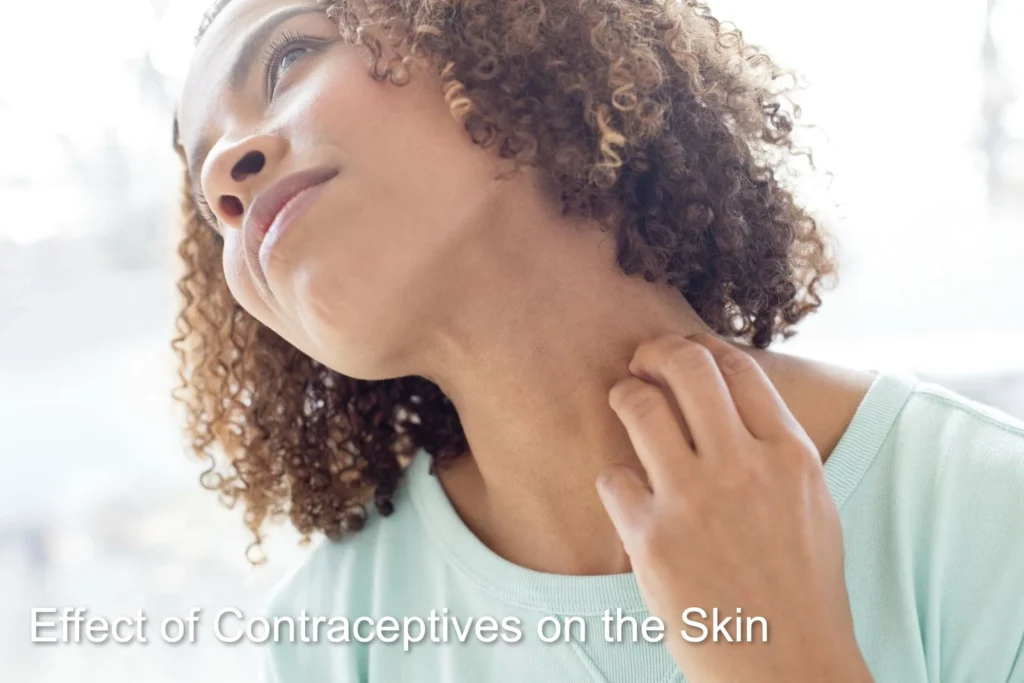
Contraceptives are mostly known for preventing pregnancy, but many women also notice changes in their skin when they start or stop using them. Some women see improvements like fewer pimples or smoother skin tone, while others struggle with new problems such as breakouts, dark patches, or dryness.
These changes happen because contraceptives influence hormones in the body. Hormones, especially estrogen, progesterone, and androgens, control oil production, skin cell turnover, and inflammation. When their balance shifts, skin often reacts.
Condoms are one of the most widely used contraceptives because they provide two important benefits: protection against pregnancy and prevention of sexually transmitted infections. They do not interfere with hormones, so they usually have no direct effect on the skin, making them suitable for people who want contraception without hormonal side effects. To ensure proper use, it is important to check the expiration date, carefully open the package, and put the condom on before any genital contact. To reduce the risk of breakage and improve comfort, a lubricant can be applied, but it should always be a type that is safe for the condom material—for instance, water-based or silicone-based lubricants are compatible with latex condoms, while oil-based ones should be avoided because they can weaken the condom.
Types of contraceptives and how they work in the body

Contraceptives come in different forms. Each works differently in the body and has its own effect on hormones. The type chosen can influence whether skin problems improve or worsen.
Main types include:
- Oral pills (combined pills and mini pills) – Contain estrogen and/or progesterone.
- Injections (Depo-Provera, etc.) – Long-acting progesterone shot.
- Patches – Stick to the skin and release hormones.
- Implants – Small rods placed under the skin, releasing hormones slowly.
- Intrauterine devices (IUDs) – Hormonal or copper. Hormonal IUDs release progesterone.
- Barrier methods (condoms, diaphragms) – No hormones, little to no skin effect.
Types of contraceptives and their possible skin impact
| Contraceptive Type | Hormones Involved | Common Skin Impact |
|---|---|---|
| Combined Pills | Estrogen + Progesterone | Often reduce acne, balance oil |
| Mini Pills | Progesterone only | May trigger acne or dryness |
| Injection | Progesterone | Sometimes causes breakouts |
| Patch | Estrogen + Progesterone | Can help with acne, but may irritate skin under patch |
| Implant | Progesterone | May cause acne in some women |
| Hormonal IUD | Progesterone | May trigger acne or dryness |
| Copper IUD | No hormones | Usually no direct skin impact |
| Barrier methods | None | No hormonal effect on skin |
Hormones and the skin – the science behind changes
Hormones are chemical messengers that tell the skin how to behave. The main ones affected by contraceptives are estrogen, progesterone, and androgens.
Estrogen
- Improves skin hydration and elasticity.
- Balances oil production.
- Helps reduce inflammation.
Progesterone
- Can make oil glands more active.
- May lead to swelling or puffiness.
- In some women, causes sensitivity.
Androgens
- Increase oil (sebum) production.
- High levels lead to clogged pores and acne.
List: Hormonal effects on skin health
- Estrogen → smoother skin, fewer breakouts
- Progesterone → possible puffiness, sensitivity
- Androgens → more oil, more pimples
Positive effects of contraceptives on the skin
Many women use contraceptive pills not only for birth control but also for clearer skin. Doctors sometimes prescribe them mainly for acne treatment.
Benefits include:
- Acne improvement – Pills with estrogen reduce androgen activity, leading to fewer pimples.
- Less oil – Skin feels less greasy.
- Fewer period breakouts – Hormonal fluctuations are steadier.
- Even tone – Estrogen helps reduce redness and inflammation.
Example:
Dr. Karen Lewis, a dermatologist, explains: “Combined contraceptive pills are one of the most effective treatments for women who struggle with persistent acne. They regulate the hormone cycle that often drives breakouts.”
Negative effects of contraceptives on the skin
Not all women experience clear skin. Some notice the opposite.
Common negative effects:
- Acne flare-ups – Especially with progesterone-only methods like injections or implants.
- Dryness – Hormone shifts can reduce natural oils.
- Hyperpigmentation (melasma) – Dark patches, especially on cheeks and forehead.
- Skin rashes – Some women react to patches or implants.
Common side effects and possible causes
| Skin Change | Likely Cause | Example |
|---|---|---|
| Breakouts | High progesterone/androgen | Acne on jawline or back |
| Dryness | Reduced estrogen | Rough or flaky skin |
| Melasma | Estrogen increase | Brown patches on face |
| Rash | Patch adhesive or implant reaction | Red itchy spots |
Factors that make reactions different in each person
Not every woman responds the same way. Some glow, others break out.
Key factors:
- Age – Teenagers may notice more acne; older women may see dryness.
- Genetics – Family history of acne or pigmentation plays a role.
- Skin type – Oily, dry, or sensitive skin reacts differently.
- Lifestyle – Stress, poor sleep, smoking, and diet worsen side effects.
Example:
A 25-year-old with oily skin may see improvement on combined pills, while a 35-year-old with dry skin may notice irritation.
Tips to manage skin changes while on contraceptives
If skin problems appear, small changes in skincare and lifestyle can help.
Emergency contraceptives do not imply protection against sexually transmitted diseases and thus are advised to be used together with a condom. Being aware of the use of emergency options and doing it carefully, it is easy to keep reproductive health under control without the risks that might be endured. Learning what distinguishes the regular and the emergency contraception can be used to make informed decisions.
Skincare routine tips
- Use a gentle cleanser (avoid harsh scrubs).
- Moisturize even if skin is oily.
- Apply sunscreen daily (to prevent melasma).
- Use acne treatments like benzoyl peroxide or salicylic acid.
Lifestyle habits
- Drink enough water.
- Eat fruits and vegetables.
- Reduce sugar and greasy foods.
- Manage stress with exercise or relaxation techniques.
List: Everyday steps to protect skin
- Wash face twice daily.
- Never sleep with makeup.
- Change pillowcases often.
- Avoid touching face too much.
Expert opinions and research findings
Studies show mixed results depending on contraceptive type.
- A 2020 dermatology review found that combined pills reduced acne in most women within 6 months.
- A study on hormonal IUDs showed higher rates of acne, especially in women under 25.
Expert Insight:
Dr. Lina Shah, gynecologist, says: “It’s not one-size-fits-all. Some women thrive on combined pills, others struggle. Trial and adjustment with medical supervision is key.”
Conclusion
Contraceptives can improve or worsen skin, depending on the method and the individual. Estrogen-rich pills usually help acne, while progesterone-only options sometimes cause breakouts.
Key takeaways:
- Effects differ for every woman.
- Skin reactions are tied to hormones.
- Skincare and lifestyle choices make a difference.
- Consulting a doctor is the safest way to manage both birth control and skin health.
Women should weigh both benefits and side effects when choosing a contraceptive. Clear communication with doctors and attention to skin changes are the best strategies for achieving both reproductive and skin health goals.
